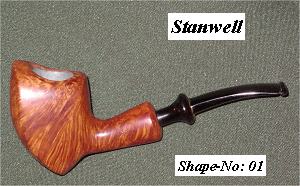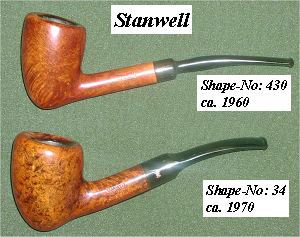The History of Danish Pipes

by Jakob Groth (DK) - adapted and
illustrated by Jörg Lehmann
With kind permission
Other prestigious Workshops
Another workshop that has to be mentioned here is Pibe-Dan (Pipe-Dan), which unfortunately closed in 1991. Pipe-Dan was the Mekka for lovers of hand made pipes made by individual pipe makers. Pipe-Dan sold many of the leading Danish Pipemakers pipes in the Store. Even some of the unknown pipe makers sold their first pipes in Pipe-Dan before they became famous.
Pipe-Dan would always let the pipemaker stamp his own name in it along with the Pipe-Dan name. Pipe-Dan had a workshop, but mostly did repair work. Pipe-Dan had a line of pipes that was called "shape reformed", which meant reshaping traditional shapes. Some of the Pipe-Dan pipes were carved in the workshop which was next to the Store, by Tom Eltang and Ph. Vigen for example. Yet another workshop that had a very good reputation in the 60's was the workshop of Hans Hartmann, though it never did generate a school. The most famous pipemaker who in his very young days had inspiration from Hans Hartmann was Per Hansen (S. Bang Pibemageri). Besides these important workshops many pipe factories started and grew. Danish Design had won a good reputation, and in the less expensive lines a lot of semi-hand cut freehand and fancy pipes were sold. The pipe manufacturers could sort of ride on the wave of fancy pipe popularity. Today, we here in Scandinavia have an indulgent smile towards these "fancy creations". These were names such as Preben Holm, Karl-Erik and Erik Nørding. All three survived because they had the ability to change their shaping when the market for fancy pipes decreased and higher quality was in demand.
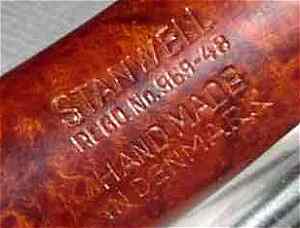
Stanwell
When
one talks about Danish Pipes, it is impossible to ignore the importance of Stanwell.
On the contrary to what one might think, there is little contradiction between
the factory made pipes from Stanwell and the hand made pipemaker pipes. They are
two sides of the creative Danish pipe environment where both sides gain from the
other. Early in the 50's Poul Nielsen Stanwell started to collaborate with
Sixten Ivarsson.
Poul Nielsen Stanwell realized in order for the Stanwell factory to survive, that besides producing all the traditional classic (English) shapes he had to make the new Danish Design as well. Therefore, Stanwell introduced several of the new Ivarsson Shapes, many of them still in production today. Later other pipemakers contributed to the design of Stanwell. The 50th Anniversary Jubilee set of 6 pipes from Stanwell is a tribute to Danish pipemakers and partly shows the debt of Stanwell to Danish pipemaking. The set includes one bulldog (Stanwells first pipe from the 40's) and five pipes created by master Danish pipemakers: Sixten Ivarsson (2), Jess Chonowitsch, Anne Julie and Tom Eltang. Even today this cooperation is fruitful; many new Stanwell shapes are created by pipemakers, while some pipemakers have their pipes sandblasted on Stanwell's machinery, and they can hand pick particularly beautiful pieces of bamboo or even plateau briar blocks.
In the mid 70's the time of the larger workshops ended. Sixten Ivarsson was getting too old to have pupils, Anne Julie prefered to run the workshop alone. W.Ø. Larsen closed the workshop and instead contracted to buy straight grain hand made pipes from individual pipemakers and then had their own Larsen name stamped on them; also a lot of factory made pipes and semi-hand cuts were sold under the W.Ø.Larsen name. The pipemakers that have emerged since that time have studied with one pipemaker or worked in a pipe factory and then become independent and learned by doing, developing their own style and design.
In
the late 90's we have had a pipe boom, in the USA in particular, following the
cigar boom in the mid 90's. This is not the first time; it seems to happen every
5 to 15 years. Each time new pipemakers emerge. It is first after the boom we
can see who makes the quality that can survive.
_______________
A
few other things must be mentioned before we look at the individual pipemakers:
Grading. Some pipe collectors seem to be very keen about the grading of the pipes. This is a little strange for us here in Scandinavia, since pipemaker pipes here rarely are graded, whether sold directly from the pipemakers workshop or from a pipe shop. A few pipemakers grade all pipes; more grade the very best pipes, only a few per year; and many do not grade. The primary reason for pipemakers to grade the exported pipes is that if the pipe has a burn out (which never happens if a pipe is smoked gently), and the pipemaker wants to replace the pipe, he wants to replace it with a pipe in the same price level. Grading generally refers only to the perfection of the grain and the quality of the wood (more or less flawless). It does not refer to the smoking quality. In Scandinavia we think that if you see a pipe that you like; you should buy it - graded or not.
Briar. Another thing that we do not care so much about here in Scandinavia is the origin of pipemaker's briar. The price of the briar blocks is not so expensive relative to the final price of the pipe. Most of the high price of a handmade pipe comes from the large amount of handwork not the price of the raw material. On the other hand the very best blocks with perfect grain, tight wood and few or no flaws can perhaps double income, with the same amount of work. Furthermore the pipemakers buy the briar plateau blocks in large quantities, so when they buy it is very important that the briar is the best quality. A Danish pipemaker expressed it like this: "Don't worry about the briar, that is the pipemakers responsibility."
Any copying, publication or reproduction of the papers and / or pictures published herein in printed or electronic media is strictly prohibited without the explicit written consent of these pages' owner. (c) Pipendoge, 2009
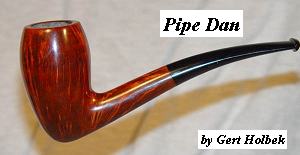
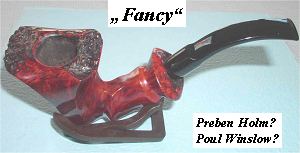
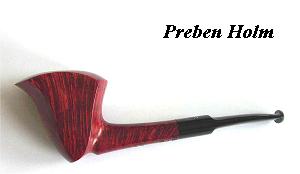
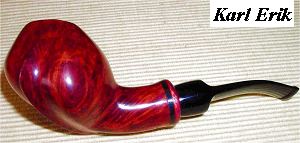
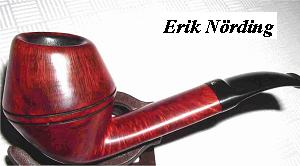
_____________
